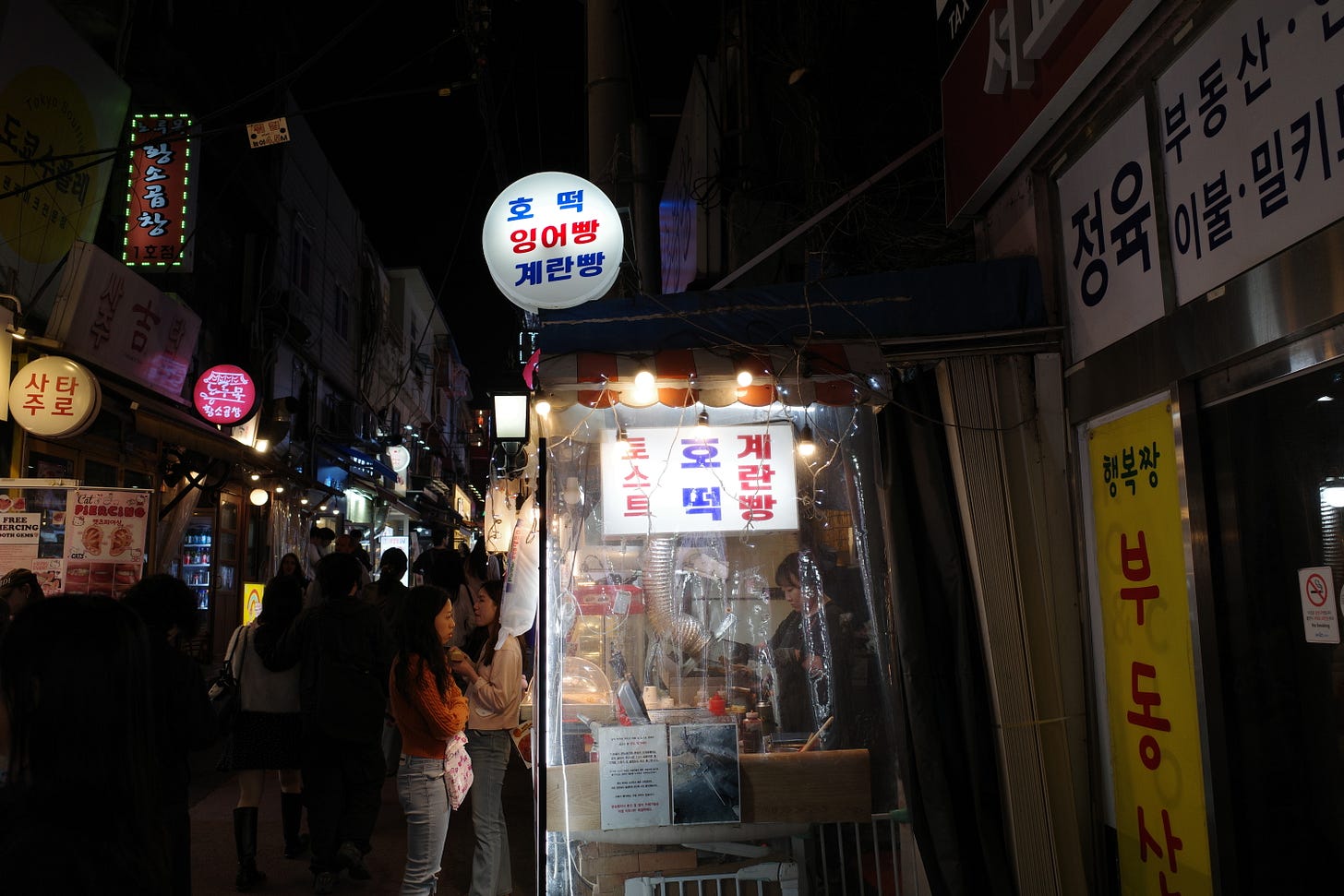When my family and I touched down in Korea for the first time this past month, it was already dark. It was so late that we were afraid that nothing would be open and that we’d have to scramble to find food after dropping off our luggages. But luckily our fears were completely assuaged when we saw the city come to life in the wee hours of the morning. There were even shopping complexes in the neighborhood where we stayed that opened at 9pm (and stayed open till 5am). We were relieved to see street food stalls set up outside one of these malls that were the absolute perfect thing for our jet-lagged bodies. Vendors tossed bouncy japchae and jjajangmyeon in their pans and snipped pajeon into bite-sized pieces with scissors. Others sold kimbap, roasted sweet potatoes, or freshly grilled skewers of chicken and leeks. I was instantly comforted knowing that I would be surrounded by food at all hours of the day to quell any jet-lag-induced hunger pangs.
I’ve always loved living in places that are bustling at night and fall asleep best to the sound of cars, and even drunken revelry, outside my window. It makes Seoul’s nightlife not only invigorating but comforting. I love the the 24/7 glow of its vending machines, arcades, and convenience stores. I love that you can get the lightest, crispiest fried chicken at pretty much any hour of the night. Neighborhoods like Hongdae feel most alive at night with college students, tourists, and locals alike meandering through the streets. Seoul rewards night owls.
In a slim book of short stories I picked up at a Kyobo Bookstore by Oh Jung Hee, a lonely character in one story is nourished by street food in Jongno:
“As always when she was hungry, Hye-ja’s mouth watered for a heaping bowl of white rice; seafish swabbed in oil and grilled; piping hot fried scallion cakes; and all the rest… Clutching her belly and looking about, Hye-ja finally spied a streetside snack-wagon, its canvas curtains brightly lit from inside.”
I was drawn to this book because the writer’s stream-of-consciousness style has been compared to that of Woolf. Despite her critical acclaim in Korea, it seems that English translations of her work are limited. This title in itself is very hard to find outside of Korea. I really enjoyed the three stories in here, which all illuminate the rich inner worlds of female protagonists in Seoul and Incheon. “Chinatown” is a bildungsroman set in Incheon, in which a young girl comes to understand beauty, cruelty, and womanhood in the aftermath of the Korean War. “The Wayfarer” is the story of a woman who has a feverish night in Jongno after being released from a hospital and realizing that she can no longer return to the life she once had. Finally, “The Release” is about a widowed woman visiting a cemetery, accompanied by her mother, to pay her respects to her father and husband. Like Woolf’s writing, the plots of these stories are less important than the meditations and beautiful prose they’re filled with, which is my kind of book. Take this passage from “Chinatown” for example:
“I drank in the wind that had been blowing all night from the East China Sea, and the seaweed smell it carried. I saw the oblong light framed by the open shutter of the two-story house on the Chinatown hill, and imagined a pale face revealed there. I felt the soft breath of spring hiding in the chilly air. Something was budding in my warm blood, something unbearably ticklish. ‘Life is…’ I murmured. But I couldn’t find the right word. Could it be found, a single word for today and yesterday, with their jumble of indistinguishable, all too complicated colors, a word to embrace all the tomorrows?”
I really enjoyed Oh’s writing style, which feels earnest and searching but not in a way that feels cloying. It was interesting to have a window into the work of an important twentieth century Korean writer, as well. I just wish writers like Oh were more widely translated.
I read this book pretty much every free moment I had and, like the delicious street food, I finished it quickly.








